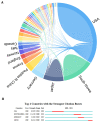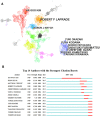Global research status and hotspot analysis of meniscal root tears based on the WOS database
- PMID: 36157400
- PMCID: PMC9500340
- DOI: 10.3389/fsurg.2022.944566
Global research status and hotspot analysis of meniscal root tears based on the WOS database
Abstract
Background: Meniscal root tears are one of the common diseases in the field of orthopedics and sports medicine today and are the subject of many current investigative efforts.
Purpose: This study aims to identify and evaluate the global trends, hotspots and frontiers in meniscal root tear research using bibliometric analysis.
Methods: A bibliometric analysis of research findings related to meniscal root tears over the past three decades was performed. CiteSpace was used to conduct document co-citation and cluster analyses on the collected data. The research was conducted based on the following factors: country and institution distribution, chronological distribution, source journal analysis, keyword co-occurrence analysis, and reference co-citation analysis.
Results: A total of 626 research articles on meniscal root tears in English published from 1989 to 2021 were obtained. There was a significant upward trend in the total number of scientific publications over the past decades, especially in 2015-2020. The most productive countries, institutions, journals and authors are the USA, STEADMAN PHILIPPON, KNEE SURGERY SPORTS TRAUMATOLOGY ARTHROSCOPY , and LAPRADE RF. North America and East Asia made outstanding contributions to the research on meniscal root tears, but cooperation and exchanges between countries and institutions were not close enough. A total of 9 clusters were obtained from the citation analysis, and 8 clusters were obtained from the keyword analysis. The main keywords that ranked first were posterior root tear, medial meniscus, menisci tibial, and ACL reconstruction, and these clusters combined with the corresponding emergence reflected the current status of research at different times.
Conclusion: Research in this field over the past 32 years has gone through a phase of exploration in the understanding of the anatomy of the meniscal root and the diagnosis of this disease and a phase of development with in-depth biomechanical studies and improved and innovative surgical techniques. The current research focuses on the innovation of meniscal root tear repair techniques, the long-term efficacy of surgery, the variability in the efficacy of different surgical techniques, and surgical strategies for combined injuries. There will be more breakthroughs in surgical techniques, surgical equipment and surgical materials to resolve meniscal root tears.
Keywords: CiteSpace; VOSviewer; meniscus; research hotspots; research status; root tear; web of science.
© 2022 Wang, Huang, Qi, Bao and Xu.
Conflict of interest statement
The authors declare that the research was conducted in the absence of any commercial or financial relationships that could be construed as a potential conflict of interest.
Figures








Similar articles
-
A bibliometric and visualized analysis of meniscus suture based on the WOS core collection from 2010 to 2022: A review.Medicine (Baltimore). 2023 Nov 17;102(46):e34995. doi: 10.1097/MD.0000000000034995. Medicine (Baltimore). 2023. PMID: 37986335 Free PMC article. Review.
-
Emerging research trends and foci of studies on the meniscus: A bibliometric analysis.J Orthop Surg (Hong Kong). 2020 Sep-Dec;28(3):2309499020947286. doi: 10.1177/2309499020947286. J Orthop Surg (Hong Kong). 2020. PMID: 32806989 Review.
-
Global research status of anterior cruciate ligament reconstruction: a bibliometric analysis.EFORT Open Rev. 2022 Dec 21;7(12):808-816. doi: 10.1530/EOR-21-0065. EFORT Open Rev. 2022. PMID: 36541554 Free PMC article. Review.
-
Posterior root tear of the medial and lateral meniscus.Arch Orthop Trauma Surg. 2014 Feb;134(2):237-55. doi: 10.1007/s00402-013-1873-8. Epub 2013 Dec 10. Arch Orthop Trauma Surg. 2014. PMID: 24323059
-
Incidence and Healing Rates of Meniscal Tears in Patients Undergoing Repair During the First Stage of 2-Stage Revision Anterior Cruciate Ligament Reconstruction.Am J Sports Med. 2019 Dec;47(14):3389-3395. doi: 10.1177/0363546519878421. Epub 2019 Nov 6. Am J Sports Med. 2019. PMID: 31693386
Cited by
-
A bibliometric analysis of the application of physical therapy in knee osteoarthritis from 2013 to 2022.Front Med (Lausanne). 2024 Sep 3;11:1418433. doi: 10.3389/fmed.2024.1418433. eCollection 2024. Front Med (Lausanne). 2024. PMID: 39290392 Free PMC article. Review.
-
Application of hydrogels in cancer immunotherapy: a bibliometric analysis.Front Immunol. 2024 Aug 13;15:1433050. doi: 10.3389/fimmu.2024.1433050. eCollection 2024. Front Immunol. 2024. PMID: 39192983 Free PMC article.
-
Medial Meniscus Posterior Root Tear: How Far Have We Come and What Remains?Medicina (Kaunas). 2023 Jun 21;59(7):1181. doi: 10.3390/medicina59071181. Medicina (Kaunas). 2023. PMID: 37511993 Free PMC article. Review.
-
Global trends and research landscape of arthroscopic therapy and exercise rehabilitation in meniscal tear: a bibliometric analysis.J Orthop Surg Res. 2025 Aug 7;20(1):735. doi: 10.1186/s13018-025-06164-6. J Orthop Surg Res. 2025. PMID: 40775349 Free PMC article.
-
Moderate methodological quality in the 50 most cited studies on meniscus root tears: A bibliometric study and methodological quality analysis.J Exp Orthop. 2025 Jul 2;12(3):e70318. doi: 10.1002/jeo2.70318. eCollection 2025 Jul. J Exp Orthop. 2025. PMID: 40612042 Free PMC article. Review.
References
Publication types
LinkOut - more resources
Full Text Sources
Miscellaneous

